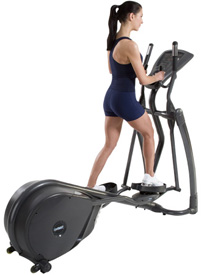 For most, impact exercise is a good thing. The more force you apply to your bones, the stronger they become. Unfortunately, the vast majority of the population is physically falling apart due to being sedentary, overweight, and all around just plain horrible to ourselves.
For most, impact exercise is a good thing. The more force you apply to your bones, the stronger they become. Unfortunately, the vast majority of the population is physically falling apart due to being sedentary, overweight, and all around just plain horrible to ourselves.
To be fair, many have legitimate joint and bone injuries, or are recovering from surgeries that also require them to stick to low and no impact modes of exercises. There is no shame in that. Low or no impact doesn’t have to mean taking it easy- it just means working out differently. You can get just as intense of a workout while still being mindful of your limitations.
Low Impact Cardio
To determine if something is high impact, ask yourself if your feet leave the floor, and how hard they come back in contact with it. Your bones and joints are required to absorb the shock, and the impact of this can be too much for many.
Running and walking are the most common forms of cardio, but both put a lot of stress on the bones and joints making them high impact exercises. For the healthy, this is the perfect form of cardio: your heart rate sky rockets and your bones strengthen. However, for those that are told to follow a low impact exercise program, stay away. (Just don’t run away, ha!)
You can still work up a sweat without pounding your joints to dust. Swimming is a zero impact form of cardio that many find to be more intense than traditional forms like running. The water provides resistance against your whole body without any impact at all.
 For those who can handle a little bit of impact, walking may be a safe route if you take it slow. The elliptical is a non impact mode of cardio as your feet never leave the machine, but being in the upright position may make it too difficult for those with no impact requirements. Same for the recumbent bike: the seated position takes the load off your feet, but if your knees are the main culprit for your pain, you may find the circular movement uncomfortable.
For those who can handle a little bit of impact, walking may be a safe route if you take it slow. The elliptical is a non impact mode of cardio as your feet never leave the machine, but being in the upright position may make it too difficult for those with no impact requirements. Same for the recumbent bike: the seated position takes the load off your feet, but if your knees are the main culprit for your pain, you may find the circular movement uncomfortable.
Strength Training on a Low Impact Plan
It is especially important to get in adequate strength training when following a low impact exercise plan. As I stated before, form follows function when it comes to your bones, so the harder you use them, the stronger they become.
Impact exercises strengthen bones, but once those activities are eliminated, one must rely solely on strength training for bone building. This is especially important for women as they age, as bones begin the weaken due to less estrogen being produced.
More often than not on a low impact regimen squats and lunges are to be avoided, so seated lower body exercises are usually a safe bet, but always ask your doctor first for safe exercise recommendations, as this will vary depending on your specific medical situation.
